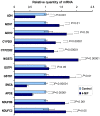Endogenous methanol regulates mammalian gene activity
- PMID: 24587296
- PMCID: PMC3937363
- DOI: 10.1371/journal.pone.0090239
Endogenous methanol regulates mammalian gene activity
Abstract
We recently showed that methanol emitted by wounded plants might function as a signaling molecule for plant-to-plant and plant-to-animal communications. In mammals, methanol is considered a poison because the enzyme alcohol dehydrogenase (ADH) converts methanol into toxic formaldehyde. However, the detection of methanol in the blood and exhaled air of healthy volunteers suggests that methanol may be a chemical with specific functions rather than a metabolic waste product. Using a genome-wide analysis of the mouse brain, we demonstrated that an increase in blood methanol concentration led to a change in the accumulation of mRNAs from genes primarily involved in detoxification processes and regulation of the alcohol/aldehyde dehydrogenases gene cluster. To test the role of ADH in the maintenance of low methanol concentration in the plasma, we used the specific ADH inhibitor 4-methylpyrazole (4-MP) and showed that intraperitoneal administration of 4-MP resulted in a significant increase in the plasma methanol, ethanol and formaldehyde concentrations. Removal of the intestine significantly decreased the rate of methanol addition to the plasma and suggested that the gut flora may be involved in the endogenous production of methanol. ADH in the liver was identified as the main enzyme for metabolizing methanol because an increase in the methanol and ethanol contents in the liver homogenate was observed after 4-MP administration into the portal vein. Liver mRNA quantification showed changes in the accumulation of mRNAs from genes involved in cell signalling and detoxification processes. We hypothesized that endogenous methanol acts as a regulator of homeostasis by controlling the mRNA synthesis.
Conflict of interest statement
Figures








Similar articles
-
Methanol may function as a cross-kingdom signal.PLoS One. 2012;7(4):e36122. doi: 10.1371/journal.pone.0036122. Epub 2012 Apr 26. PLoS One. 2012. PMID: 22563443 Free PMC article.
-
Dietary methanol regulates human gene activity.PLoS One. 2014 Jul 17;9(7):e102837. doi: 10.1371/journal.pone.0102837. eCollection 2014. PLoS One. 2014. PMID: 25033451 Free PMC article.
-
Gene array profiles of alcohol and aldehyde metabolizing enzymes in brains of C57BL/6 and DBA/2 mice.Alcohol Clin Exp Res. 2006 Oct;30(10):1659-69. doi: 10.1111/j.1530-0277.2006.00201.x. Alcohol Clin Exp Res. 2006. PMID: 17010133
-
Enzymology of ethanol and acetaldehyde metabolism in mammals.Arch Med Res. 1997 Winter;28(4):453-71. Arch Med Res. 1997. PMID: 9428569 Review.
-
Overview of the role of alcohol dehydrogenase and aldehyde dehydrogenase and their variants in the genesis of alcohol-related pathology.Proc Nutr Soc. 2004 Feb;63(1):49-63. doi: 10.1079/pns2003327. Proc Nutr Soc. 2004. PMID: 15099407 Review.
Cited by
-
Treatment with 4-methylpyrazole modulated stellate cells and natural killer cells and ameliorated liver fibrosis in mice.PLoS One. 2015 May 29;10(5):e0127946. doi: 10.1371/journal.pone.0127946. eCollection 2015. PLoS One. 2015. PMID: 26024318 Free PMC article.
-
The metabolic recovery of marathon runners: an untargeted 1H-NMR metabolomics perspective.Front Physiol. 2023 May 4;14:1117687. doi: 10.3389/fphys.2023.1117687. eCollection 2023. Front Physiol. 2023. PMID: 37215177 Free PMC article.
-
The Antioxidant Cofactor Alpha-Lipoic Acid May Control Endogenous Formaldehyde Metabolism in Mammals.Front Neurosci. 2017 Dec 1;11:651. doi: 10.3389/fnins.2017.00651. eCollection 2017. Front Neurosci. 2017. PMID: 29249928 Free PMC article.
-
Formate metabolism in health and disease.Mol Metab. 2020 Mar;33:23-37. doi: 10.1016/j.molmet.2019.05.012. Epub 2019 Jul 30. Mol Metab. 2020. PMID: 31402327 Free PMC article. Review.
-
Unraveling the Extracellular Metabolism of Immortalized Hippocampal Neurons Under Normal Growth Conditions.Front Chem. 2021 Apr 16;9:621548. doi: 10.3389/fchem.2021.621548. eCollection 2021. Front Chem. 2021. PMID: 33937186 Free PMC article.
References
-
- von Dahl CC, Hävecker M, Schlögl R, Baldwin IT (2006) Caterpillar-elicited methanol emission: a new signal in plant-herbivore interactions? Plant J 46: 948–960. - PubMed
-
- Restani P, Galli CL (1991) Oral toxicity of formaldehyde and its derivatives. CRC Crit Rev Toxicol 21: 315–328. - PubMed
-
- Tephly TR (1991) The toxicity of methanol. Life Sci 48: 1031–1041. - PubMed
-
- Thompson CM, Ceder R, Grafström RC (2010) Formaldehyde dehydrogenase: beyond phase I metabolism. Toxicol Lett 193: 1–3. - PubMed
Publication types
MeSH terms
Substances
LinkOut - more resources
Full Text Sources
Other Literature Sources

